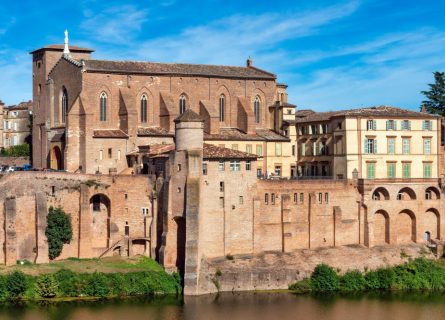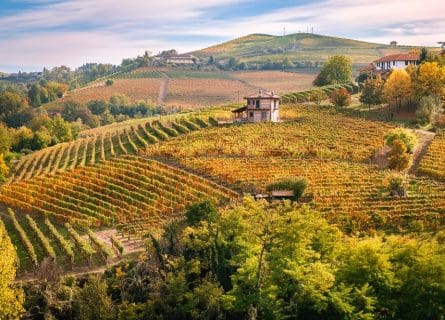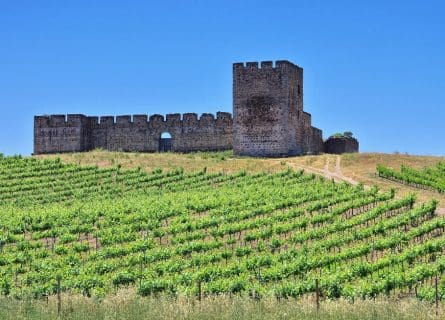Gaillac & Fronton Wine Regions Guide
Rediscover the Heart of French Wine Tradition: Gaillac and Fronton's Undiscovered Gems Await
EXPLORE ALL OUR SOUTH WEST FRANCE WINE REGION GUIDE
Last updated: April 4, 2025
Introduction
To the north and east of Toulouse, flanked by the River Tarn and bathed in Mediterranean sunshine, the vine flourishes in a forgotten corner of France. Yet there is much to enjoy in the undulating landscapes of Gaillac and Fronton, not least a glacial pace of life, beautiful countryside, hearty gastronomy, and delicious local wines!
Globalization – and ubiquitous varieties – have scarcely made inroads in the vineyards of the Southwest, where esoteric gems like Braucol, Négrette, and Ondenc generally rule the roost. Indeed, both areas offer an enviable collection of indigenous wine grapes that have yet to become global sensations. For that reason alone, Gaillac and Fronton deserve your undivided attention.
Discover More About French Wine
History

Wine experts and historians believe that people cultivated vines along the banks of the Tarn and Garonne well before viticulture became big business in Bordeaux. Yet the vineyards of Gaillac and Fronton never achieved the fame of Pauillac and Margaux in the 20th century, lacking both the capital and the human resources needed to compete with their rivals downstream in the Gironde.
Nevertheless, the bucolic scenery of the Southwest greatly captivated the Romans; Tolosa (Toulouse) thrived as a center of trade, commerce, and agriculture under their influence. Today, the city’s medieval streets ooze a rich and complex history – the Germanic Visigoths captured Tolosa after the collapse of the Western Roman Empire in the 5th century. They held onto this lucrative prize until AD 507 when the Merovingian and Carolingian dynasties began asserting dominance in the Dark Ages.
Viticultural Development in the Middle Ages
However, Toulouse maintained a great deal of independence in the Middle Ages, with the powerful and influential counts of Toulouse inspiring fear in their enemies. Viticulture, meanwhile, had become a subject of keen interest to the Catholic Church and its orders of Benedictine and Cistercian monks. Under the direction of the monasteries, vines carpeted the hills and valleys of the Tarn, supplying the counts of Toulouse with their daily tipple.
And, like the wines of Bordeaux, people in the taverns of England and the Low Countries consumed them with gusto in the 13th and 14th centuries. Meanwhile, Toulouse merchants grew wealthy from the blue dye trade until competition from Portugal (who imported indigo from India) forced them out of business.
Advent of Phylloxera
Yet wine remained an important part of the Toulouse economy, with Gaillac and Fronton finding favor in the bistros and restaurants of Paris; they also served a more ignoble purpose, adulterating the pallid wines of Bordeaux. Sadly, the phylloxera louse, a deadly pest accidentally imported from the US by visiting botanists, devastated much of the area under vine.
A viable solution emerged in the early 20th century: botanists had to regraft European vines onto American rootstock. This massive endeavor unfolded across key regions in the south of France, leading to the eventual recovery of the wine trade.
Today, Gaillac and Fronton are relatively small vineyards in the Southwest with little renown in export markets. Fortunately, there is enough demand at home and from tourists to sustain these beautiful and inviting regions.
Geography and terroir

The vineyards of the Tarn are sleepy, tranquil, and relatively undiscovered. Like most regions in the Southwest, local grape varieties populate Gaillac and Fronton, attracting little global attention to these charming and esoteric wines. Gaillac, the larger of the two, sits in the hilly country west of Albi–Toulouse.
There are approximately 3150 hectares under vine, spread over 64 communes and 73 villages in the wider region; a further nine communes are located east of Albi, mainly south of the river. The landscape invites favorable comparisons with Tuscany: this is an area of rolling green pasture-land interspersed with vines, studded with hilltop villages and sleepy hamlets. It is the ideal place to retire – especially if you crave peace and quiet.
Harvest time witnesses a flurry of activity in the hills of Gaillac. Producers in the appellation cultivate red and white grapes, using them to create an eclectic mix of red, white, rosé, and sparkling wines. Indeed, they fully leverage the region’s exceptional soils: they find terroirs rich in limestone with a smaller percentage of sand and silex (flint) closer to the river banks. The former suits the production of fresh and fragrant whites (still and sparkling) perfectly, while the best reds from Gaillac emanate from the heavier and deeper clay soils overlaid with gravel. For that reason, dark-skinned grapes tend to dominate and work best on the gravel-clay soils south of the Tarn and around Cunac, to the east of Albi.
Gaillac Premières Côtes: A Subregion of Distinction
In addition, there is a subregion known as Gaillac Premières Côtes. Authorities created the appellation in 1938; it applies to superior vineyards on the north bank of the Tarn, where calcareous soils produce pungently aromatic and very complex dry whites. These wines rank among the finest made in the Southwest today.
A Legacy of the Knights Templar
Immediately to the west, between the Tarn and the Garonne, Fronton continues to produce a small volume of high-quality wine that usually disappears into the cellars of Toulouse. According to the AOC rules, vineyard owners must plant at least 50 percent of their vines (covering around 2400 hectares) with Négrette.
Legend has it that the Knights Templar brought this very rare grape from the Middle East during the Crusades. The most promising climats (vineyard sites) are located on the lower slopes of the Fronton hills, rising to a very gentle 200 meters above sea level. Twenty communes have the entitlement to produce Fronton, cultivating grapes on the zone’s acidic sandy-clay soils, locally known as “boulbène.”
The Rich Terroir and Climate of Fronton
But on the banks of the Tarn, outcrops of gravel yield the most fragrant and complex reds in the appellation. Like Gaillac, Fronton enjoys a semi-continental climate, with dry summers and relatively mild winters. Overall, it is a very benign and advantageous place to grow vines.
Winemaking and regional classifications
Winemakers in Gaillac and Fronton are passionate advocates of local grapes and original tastes. The AOC rules permit only a small percentage of Bordeaux varieties in the blends and do not sanction single-varietal wines. Thus, while Cabernet Sauvignon, Merlot, and Cabernet Franc may occasionally appear in Gaillac Rouge, they are never allowed to dominate.
Crafting Distinctive Reds
Instead, growers take great pride in coaxing fragrance and finesse out of the peppery Braucol and much lighter Duras. When blended with Syrah, however, they produce a very structured and concentrated style of red, with aromas of crushed black fruits, damson, and garrigue.
The best examples will be made with all the care and attention lavished on a top Bordeaux: temperature-controlled vinification in oak vats or stainless steel, a relatively lengthy post-fermentation maceration, and maturation in French oak. They offer all the potency of Châteauneuf-du-Pape; however, the vast majority of Gaillac wines are rarely expensive. Most are sold for less than $25.
Innovating with Gaillac Primeur
That is certainly true of the early-drinking Gaillac Primeur, which was made using carbonic maceration. This technique, widely adopted in Beaujolais, yields a very light red style with little tannin – hence Beaujolais Nouveau! It involves placing whole bunches in the vat, using the top half of the container to apply pressure on the bottom half, and breaking the grape skins. Fermentation will then begin, releasing CO2 into the vat.
Meanwhile, carbon dioxide provides the catalyst for a chemical reaction in the intact berries: it activates dormant enzymes in the berries, which start to devour the carbohydrates stored within the grapes and turn them into alcohol. This is known as intracellular fermentation, a tried-and-tested method of producing light wines with soft pear drop and bubblegum flavors. These cheap and cheerful fruity reds remain very popular in Toulouse, albeit they only account for around seven percent of red wine production.
However, many of Gaillac’s greatest triumphs are its whites: sweet and dry, still and sparkling. They are made from such local curiosities as Mauzac, Muscadelle, Ondenc, Len de I’El, and Sauvignon Blanc. Modern white wines are typically bone dry, pandering to consumer tastes and the shrinking market for dessert wine styles. Nevertheless, the gently fizz and off-dry Perle and sparkling wines made via the Méthode Ancestrale (continuation of the first fermentation in bottle) often benefit from a small amount of residual sugar. The latter is a low-alcohol fizz perfect for the health-conscious age.
The Floral and Fruity Wines of Fronton
In contrast, Fronton AOC does not allow the production of white wines. But, there is much to enjoy in the floral and juicy red wines of Toulouse, led by Négrette (a minimum of 40% in the blend) and often incorporating a dash of Malbec, Syrah, Cinsault, and/or Cabernet Sauvignon. As a rule, they are best enjoyed young and slightly chilled; the same applies to Fronton pink, a combination of Négrette and a sundry of other grapes native to the Southwest. They are fruit-forward, delicious rosé wines, perfect as an aperitif.
Facts & Figures
Key wine styles
- Light and medium-bodied red wines; dry and sweet whites; rosés; sparkling wine
Appellation structure
- AOC Fronton/AOC Gaillac
Hectares under vine
- Gaillac: 3150 Fronton: 2400
Average annual production
- Gaillac: 155,000 hectoliters per annum
- Fronton: 70,000 hectoliters per annum
Approximate number of producers
- Gaillac: 120
- Fronton: 40
The lowdown

It is remarkable to think that Gaillac and Fronton were once used to beef up Bordeaux wines, particularly in weaker vintages! Yet, while people regarded this ignoble fate as inevitable in the 17th and 18th centuries, both regions harbor considerably higher aspirations today. According to French wine law, cross-regional blending will be illegal in 2024 unless we’re talking about the most generic Vin de France labels—JP Cheney, for example.
However, even in the late 1990s, a great deal of Gaillac and Fronton rouge could be very rustic and unappealing: coarse and astringent on the mid-palate. But, viticulture has been revived with enthusiasm over the past two decades in both appellations, buoyed by the growing tourist market in Toulouse.
Viticultural Innovations and Improvements
However, many improvements have taken place in the vineyard rather than the cellar. The Southwest does not generally attract multinationals and their capital; the increased sophistication in matching local grapes to specific terroirs is arguably far more beneficial than simply throwing euros at the problem. This can be seen in the exemplary red wines now being made in both regions – highly individual styles that offer a real point of difference.
Consumers who are sick of single-varietal Merlot should have a field day in the Fronton vineyards: it is hard to imagine a more esoteric and uncommon grape variety than Négrette!
Gaillac’s Global Potential
Meanwhile, Gaillac is winning plenty of pundits for its delicious reds, dry whites, and unusual sparkling wines. A diverse roll call of producers, climats, and grapes are its biggest trump card; food-friendly and elegant, with a freshness to balance their fruit, Gaillac wines have much in common with those of Sicily and Portugal’s Douro region. The best are revolutionary, yet they remain largely undiscovered globally. However, it is all the better for us as it stops prices from getting out of hand.
Key Grape Varietals
-
Len de I'El
Len de l’El is a key white wine grape from South West France, especially Gaillac, known for its unique growth far from the bud, inspiring its name meaning "far from the eye." This variety, often blended with Mauzac, Ondenc, and occasionally Sauvignon Blanc, is crucial in Gaillac's wine production, required to constitute at least half of any Gaillac white wine. Len de l'El contributes to various wine styles—dry, sweet, and sparkling—except Gaillac Méthode Ancestrale.
-
Muscadelle
Muscadelle is a white grape varietal, primarily used for blending in the production of sweet white wines in the Bordeaux region.
Find out more -
Mauzac
Mauzac: A white grape mainly grown in Gaillac and Limoux, Languedoc-Roussillon, Southern France. Often used in sparkling wines like Crémant de Limoux.
Find out more -
Sauvignon Blanc
The sauvignon blanc grape varietal, originally from the Bordeaux region of France, is now one of the world's most loved white varieties.
Find out more -
Ondenc
Ondenc, a white grape variety from southwestern France, experienced widespread cultivation in the 19th century, utilized in various wines and spirits. Its prominence dwindled, largely due to low yields and disease susceptibility, leading to its near disappearance after the phylloxera epidemic, except in its stronghold, Gaillac, and minimal presence in Australia's Barossa Valley.
-
Braucol (Fer)
Braucol is a dark-skinned grape from southwest France, notably in Marcillac AOC, producing rustic, medium-bodied reds with flavors of redcurrant, fig, and pepper. It's essential in Marcillac blends, needing to comprise at least 90% of them, and contributes to Gaillac wines. Originating possibly from Spain's Basque country or from wild grapes, Braucol faced decline during the phylloxera crisis but revived with Marcillac's mining boom
-
Duras
Duras, an ancient vine from France, is renowned for robust red wines in Gaillac, featuring dark colors and rich aromas. Now mainly found in the Tarn department, it's essential to Gaillac reds, often blended with Fer Servadou and Syrah.
-
Gamay
Gamay Noir is a grape variety used to make light-bodied red wine, most notably grown in the Beaujolais region.
Find out more -
Malbec
Delve into Malbec, a dark, small grape native to France, cherished for its thick skin and exceptional flavors. 🍇🍷
Find out more -
Négrette
Négrette, a distinctive grape from Fronton, France, traces its origins to Cyprus, reputed for its violet-scented red and rosé wines. Thriving in hot, dry conditions and iron-rich soils, it's central to Fronton AOC, demanding at least 50% in blends. While often mixed with grapes like Syrah to improve structure, its unique qualities shine in single-varietal wines.
-
Syrah
Syrah is dark-skinned and perhaps the most underrated of the 'noble' red grape varieties.
Find out more
Southwest gastronomy

Visitors must devote a day, with a luxuriously lazy lunch obligatory, to exploring the delightful towns of Fronton and Gaillac. In the summer, the old quarters of both destinations transform into one big cafe terrace, ideal for lunch and dinner. Expect traditional local dishes cooked to perfection: terrines, confit de canard, lentil cassoulet, Noir de Bigorre (black pig cured ham), and ris de veau (veal sweetbreads).
Wineries Recommended by Cellar Tours
Further Reading: Discover More Related Blog Content
More information
If you would like us to customize an exclusive luxury tour, contact us and let us know your travel plans. We offer luxury food and wine tours for private groups of a minimum two guests. In addition, all of our private, chauffeured tours are available year-round upon request.















